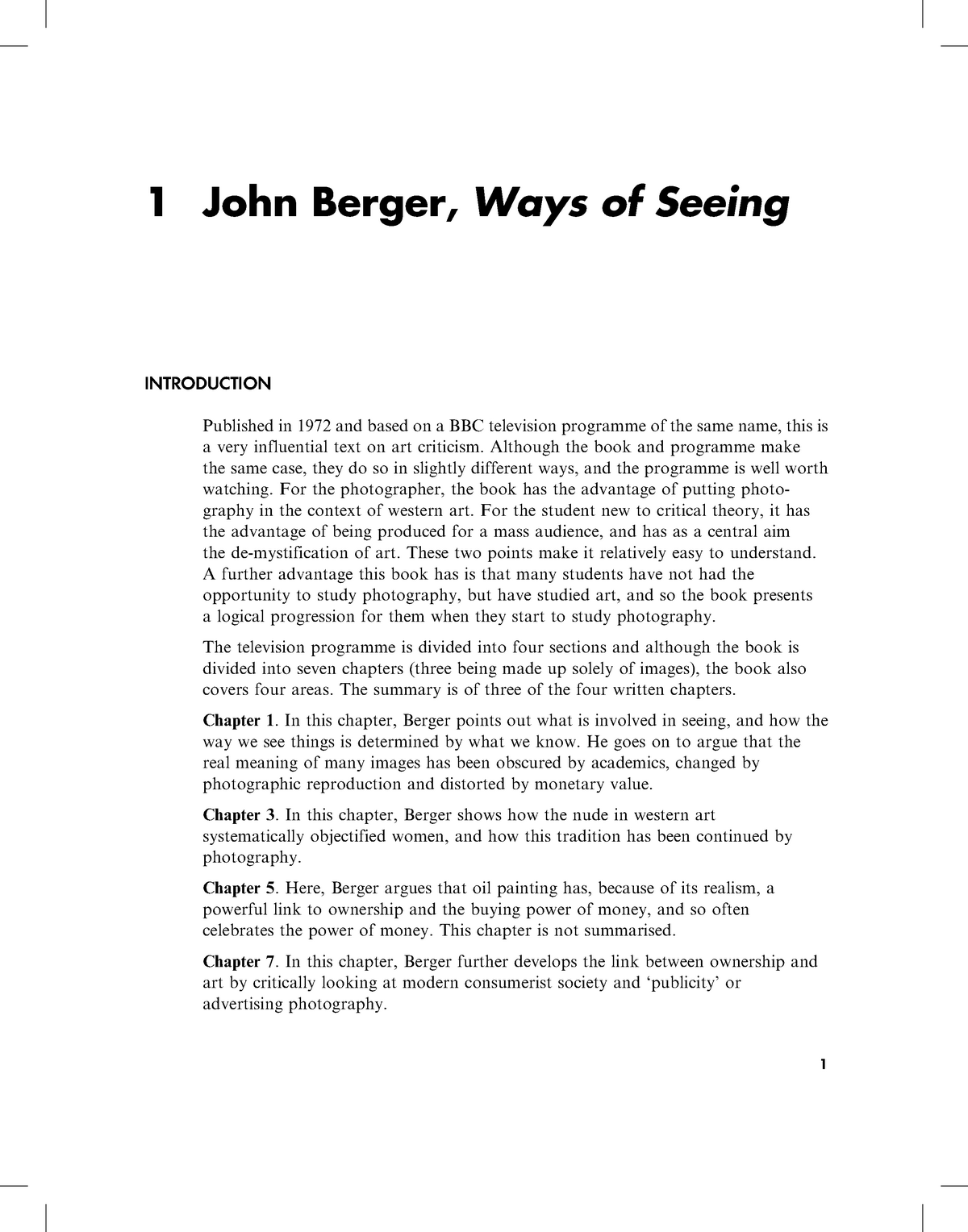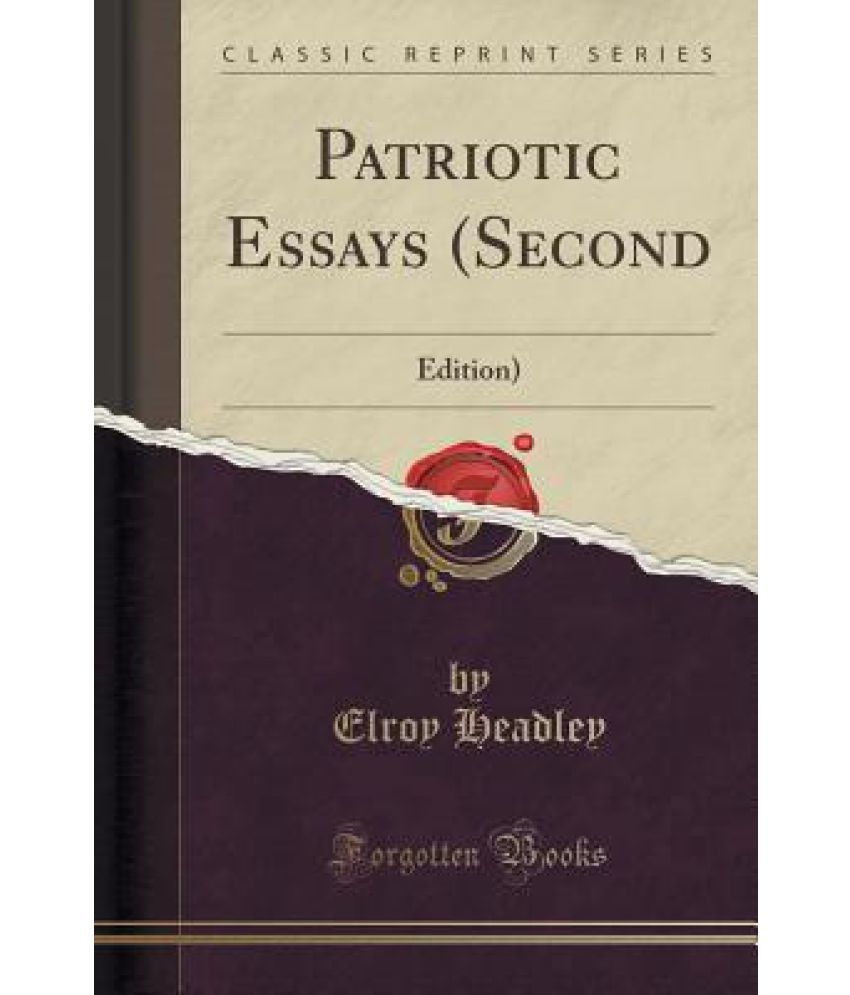
Ways Of Seeing By John Berger Words | 7 Pages. Rebecca Morin Professor Foster English Composition 10th, December, Ways of Seeing by John Berger is a set of essays used to explain different techniques used in oil paintings, advertisements, and the way people look at things differently from one another · 28 August A Different View In his essay, “Ways of Seeing”, John Berger discusses how women are seen differently then men. He describes that a woman views herself in two ways, as the surveyed and as the surveyor (Berger 4). Women are always aware of how they look as well as how others see her, especially men · The essay “ Ways of Seeing ”, written by John Berger took art as an example, to show the way how modern people view art and the influences that traditional oil painting has had on society and modern day society. The way people now a day perceives an art image is different than the way it was seen before
John Berger's "Ways of Seeing" Summary & Commentary Essay - Words
The information that comes from the silence john berger ways of seeing essay a painting is only truly experienced when looking at the original work rather than a reproduction of it. The original work speaks to you in a way that a reproduction is not able to. Berger says this clearly when he states: Original paintings are silent and still in a sense that information never is. What we make of that painted moment when it is before our eyes depends upon what we expect of art, and that in turn depends today upon how we have already experienced the meaning of paintings through reproductions, john berger ways of seeing essay.
Asking the right questions can reveal facts about the painting that one may not have known otherwise. Engaging in conversations with each work of art allowed me to dig deeper into the actual meaning, or what could be the actual meaning, of each work. The mystification that some experience when viewing art is brought about by others telling us that we should be mystified by these paintings.
We already have expectations before we even see the painting. This allows the experience to be ruined before it even happens. The fact that we view art differently because of the history that we already know about it or its author is true. Viewing a painting that was created during the Civil War era would affect us differently than someone viewing it during that time period because we know the outcome and all the events that took place during that time. That person viewing it right after it was created will receive a completely different meaning from it than we would having the knowledge of the war.
This is what I did. Taking the landscape photo from the Quinnipiac campus and comparing it to the reproduction of a landscape painting I found searching the internet brought out many new ideas and meanings about both that I would have never seen before if it had not been for the suggestions of John Berger.
The landscape photo of the Quinnipiac campus pictures the fountain with geese along with parts of sleeping giant and a partial view of the quad on a clear autumn day while the photo of the other landscape painting has a completely different setting. In this painting it is night time and very foggy. Not much can be made out specifically expect for the hills in the background and a few lights scattered around giving the idea of a city or a small town.
One of the major differences that I noticed was the clarity of the pictures. The picture of the Quinnipiac Campus is much clearer than that of the night landscape painting. The clarity gives off a multiple meanings and feelings to whoever is viewing it. Maybe the blurriness of the painting had a greater meaning and a greater purpose than just making it look more interesting. I felt that the author could have had solemn feelings when painting this. Perhaps they missed their hometown and it was just a memory to them fading away into the darkness of their minds.
Either way it was different from the feeling I got from looking at the picture of the Quinnipiac campus. Demystifying this painting made me realize the many reasons for which it could have been produced. Viewing the Quinnipiac campus photo the way I viewed the night time landscape painting was more difficult because I already knew information about the setting and the person who took the picture myself.
I tried to view the picture as if I was someone from another state who has never seen or heard of John berger ways of seeing essay University before and would not know the first thing about its campus or even where it was located, john berger ways of seeing essay. To that person this could be anywhere.
Instead of the business building pictured on the right of the photo it could be a library, or a museum. This picture could be found anywhere in the world. What was the meaning of it? Was it just a pretty sight to look at? When I was taking the photo that was basically it, but after looking at the picture from a different perspective I realized that it could be so much more.
The photo of the campus can bring about solemn feelings like that of the other landscape painting or it can bring about feelings of happiness and joy. The bare trees and the bare mountains have john berger ways of seeing essay sense of darkness that can lead a person to think that the one who took this picture must have been sad for one reason or another, john berger ways of seeing essay.
Finding sadness in this photo may seem a bit uncanny because of the beautiful day that is pictured. But then again the sky is still blue and the grass is perfectly green as if it was a beautiful summer day so the person who took the picture could have been happy as well. Even though not as obvious, this photo can, just like the landscape painting, john berger ways of seeing essay, put the viewer in a position to think that it was done for one reason but then realize that they may not be correct in their first judgment.
Engaging in conversations with the piece of art allows us to realize whether or not we believe that our first judgment of the picture was right or wrong. The way that John Berger tells us to engage in a painting allows us to see the painting without those preconceived expectations that we may already have.
By doing this John berger ways of seeing essay have learned to look at a painting for more than just the colors on a piece of paper. Looking at it for the message it is trying to speak instead of just staring blankly at it pretending I understand what it is trying to say was made possible because I followed the suggestions of John Berger. The process of demystifying the pictures allowed me to understand more deeply the reasons for their existence and this process also, in my opinion, meets the expectations that Berger sets on it.
To continue this idea of demystifying a painting, there is no single correct meaning that one can get out of a painting. Many meaning can be considered as correct depending on the circumstances. This is the beauty of art. It can be understood in many ways all depending on the person who is viewing it. I'm Erica! Would you like to get a custom essay? How about receiving a customized one? Check it out.
John Berger \
, time: 1:57:32The Analysis of the Book "Ways of Seeing" by John Berger: [Essay Example], words GradesFixer

Ways Of Seeing By John Berger Words | 7 Pages. Rebecca Morin Professor Foster English Composition 10th, December, Ways of Seeing by John Berger is a set of essays used to explain different techniques used in oil paintings, advertisements, and the way people look at things differently from one another · The essay “ Ways of Seeing ”, written by John Berger took art as an example, to show the way how modern people view art and the influences that traditional oil painting has had on society and modern day society. The way people now a day perceives an art image is different than the way it was seen before · John Berger begins his book “Ways of Seeing” by putting across the idea that words are inadequate when it comes to conveying the way we perceive the world, seeing is habit plus convention. Building upon the German philosopher, Walter Benjamins’ works, he theorizes, with the invention of the camera, the reproduction of images, concentrating on European oil paintings, changed not what we see but how we see

No comments:
Post a Comment